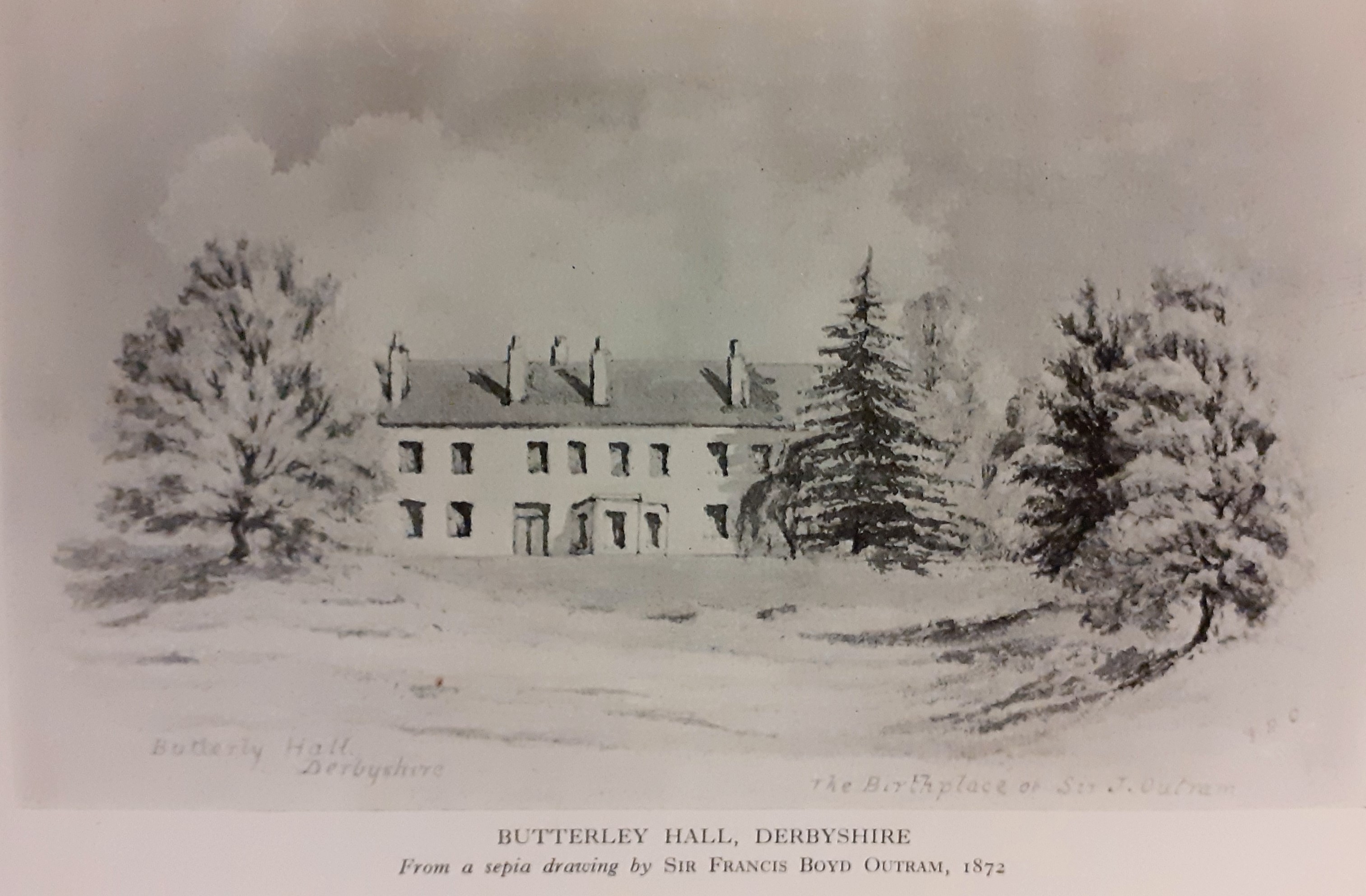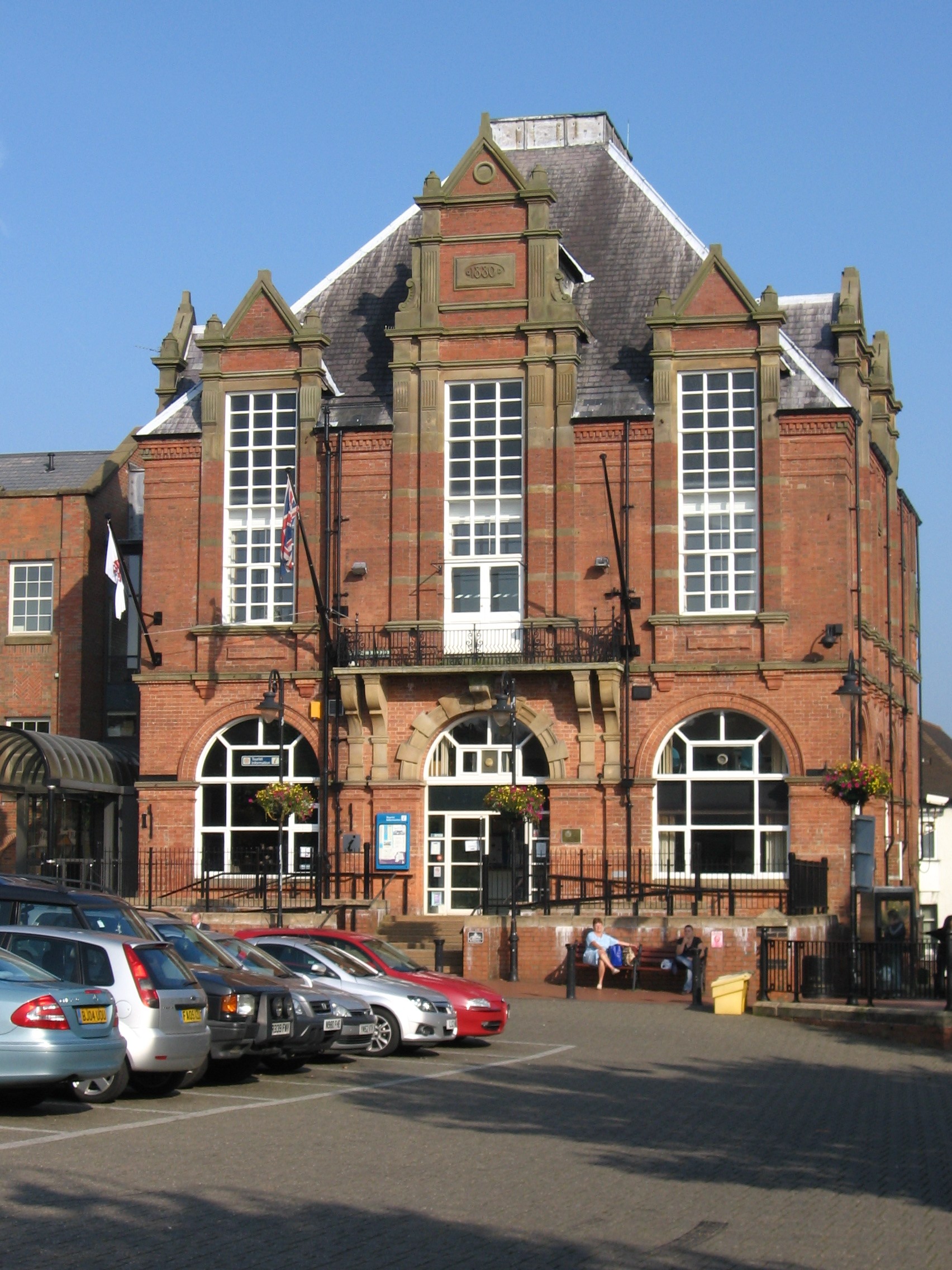|
Butterley Hall
Butterley Hall is an 18th-century country house near Ripley, Derbyshire. It is a Grade II listed building. The site is now the headquarters of the Derbyshire Constabulary. The manor of Butterley was owned by Darley Abbey until the Dissolution of the Monasteries in the 16th century. The two-storey, attic gabled eight-bayed house was built in the late 18th century for the Home family but was sold in 1790 to Francis Beresford for occupation by Benjamin Outram, founder of the Butterley Company. The Hall was the 1803 birthplace of General Sir James Outram of the Indian Army. Following Benjamin Outram's death in 1805 his business partner William Jessop took residence. His grandson, also William Jessop of Butterley Hall, was High Sheriff of Derbyshire in 1878. From 1892 to 1938 the hall was occupied by Albert Leslie Wright (1862-1938), Chairman and Managing Director of the Butterley Company, and his family. Like Jessop, Leslie Wright held the office of High Sheriff of Derbyshire i ... [...More Info...] [...Related Items...] OR: [Wikipedia] [Google] [Baidu] |
Butterley Hall, Ripley, Derbyshire
Butterley is a village in the English county of Derbyshire near to Ripley. It is the site of the Midland Railway – Butterley, as well as the old Butterley Brickworks. Notable residents *Sir James Outram, hero of the Indian Mutiny, was born at Butterley Hall in 1803. * Harry Storer Sr., goalkeeper for Arsenal F.C. and Liverpool F.C., was born here in 1870. *William Storer, professional cricketer for Derbyshire, was born here in 1867. See also *Butterley Company *Butterley Hall *Butterley Tunnel *Listed buildings in Ripley, Derbyshire Ripley is a civil parish in the Amber Valley district of Derbyshire, England. The parish contains 62 listed buildings that are recorded in the National Heritage List for England. Of these, five are listed at Grade II*, the middle of the three g ... References External links * Villages in Derbyshire Geography of Amber Valley {{Derbyshire-geo-stub ... [...More Info...] [...Related Items...] OR: [Wikipedia] [Google] [Baidu] |
Ripley, Derbyshire
Ripley is a town in the Amber Valley borough of Derbyshire, England. History Little information remains as to when Ripley was founded, but it appears in the 1086 Domesday Book, when it was held by a man called Levenot. In 1251 Henry III granted a charter for "one market one day a week, on Wednesday, at hemanor of Ryppeleg: and one fair each year lasting three days, on the Vigil Day and Morrow of St Helen". Ripley Fair antedates Nottingham Goose Fair. The market day was later altered to Saturdays, with an extra market on Fridays. Medieval Ripley was just a few stone cottages and farms around a village green, with a few dwellings further afield. Corn was ground at a mill owned by the Abbot of Darley. In 1291, Ripley had "two water-mills with fish ponds". The Ripley area has been industrialised since the late 18th century. One of the earliest firms to take advantage of local mineral resources was the Butterley Company. It was formed in 1790 by Benjamin Outram and Francis Beresf ... [...More Info...] [...Related Items...] OR: [Wikipedia] [Google] [Baidu] |
Grade II Listed Building
In the United Kingdom, a listed building or listed structure is one that has been placed on one of the four statutory lists maintained by Historic England in England, Historic Environment Scotland in Scotland, in Wales, and the Northern Ireland Environment Agency in Northern Ireland. The term has also been used in the Republic of Ireland, where buildings are protected under the Planning and Development Act 2000. The statutory term in Ireland is " protected structure". A listed building may not be demolished, extended, or altered without special permission from the local planning authority, which typically consults the relevant central government agency, particularly for significant alterations to the more notable listed buildings. In England and Wales, a national amenity society must be notified of any work to a listed building which involves any element of demolition. Exemption from secular listed building control is provided for some buildings in current use for worship, ... [...More Info...] [...Related Items...] OR: [Wikipedia] [Google] [Baidu] |
Derbyshire Constabulary
Derbyshire Constabulary is the territorial police force responsible for policing the county of Derbyshire, England. The force covers an area of over with a population of just under one million. Organisation and structure To police the county the force is divided into two territorial divisions, based respectively in the towns of Buxton and Chesterfield (North Division - covering High Peak and Derbyshire Dales District Council areas, Chesterfield, NE Derbyshire, Amber Valley and Bolsover and the villages of South Normanton and Pinxton which lie within the boundaries of Bolsover District Council), and Derby ( South Division - policing the city of Derby and the districts of Erewash, Long Eaton and South Derbyshire). The Force Headquarters, near Ripley and close to the A38 road, is Butterley Hall, former residence of Benjamin Outram and once owned by the Butterley Company. The Old Hall and later additional buildings in the large grounds house much of the force's central administra ... [...More Info...] [...Related Items...] OR: [Wikipedia] [Google] [Baidu] |
Darley Abbey
Darley Abbey is a former historic mill village, now a suburb of the city of Derby, England. It is located approximately north of the city centre, on the west bank of the River Derwent, and forms part of the Darley ward along with Little Chester and the West End. The settlement dates back to the medieval era, when it was the site of an Augustinian monastery. In the 18th century, the Evans family developed their planned industrial mill village in the area; Darley Abbey is now part of the Derwent Valley Mills World Heritage Site. The area has been a part of the city (originally borough) of Derby since 1968 and is counted as part of Darley Ward. History Darley Abbey (Monastery) The Augustinian monastery of Darley Abbey has a rather confused foundation. In 1154, Robert de Ferrers, 2nd Earl of Derby made a donation to St Helen's Priory, Derby for them to establish a new religious house. He donated the churches of Uttoxeter and Crich, an oratory and cemetery at Osmaston, a ... [...More Info...] [...Related Items...] OR: [Wikipedia] [Google] [Baidu] |
Benjamin Outram
Benjamin Outram (1 April 1764 – 22 May 1805) was an English civil engineer, surveyor and industrialist. He was a pioneer in the building of canals and tramways. Life Born at Alfreton in Derbyshire, he began his career assisting his father Joseph Outram, who described himself as an "agriculturalist", but was also a land agent, an enclosure commissioner arbitrating in the many disputes which arose from the enclosures acts, an advisor on land management, a surveyor for new mines and served as a turnpike trustee. In 1792 his neighbour George Morewood died and left his estates to Ellen Morewood. She was mining under Outram land. Over the next nine years the Outrams engaged in a legal battle with her. Land had been sold to them by the Morewoods but Ellen believed that she still had the rights to the coal and ironstone beneath them. James and Benjamin Outram disagreed and they appealed and in 1803 the Lord Chief Justice of the King's Bench, Lord Ellenborough agreed with them. ... [...More Info...] [...Related Items...] OR: [Wikipedia] [Google] [Baidu] |
Butterley Company
The Butterley Company was an English manufacturing firm founded as Benjamin Outram and Company in 1790. Its subsidiaries existed until 2009. Origins This area of Derbyshire had been known for its outcrops of iron ore which had been exploited at least since the Middle Ages. After the Norman Conquest, nearby Duffield Frith was the property of the de Ferrers family who were iron masters in Normandy. In 1793, William Jessop, with the assistance of Benjamin Outram, constructed the Cromford Canal to connect Pinxton and Cromford with the Erewash Canal. In digging Butterley Tunnel for the Cromford Canal, coal and iron were discovered. Fortuitously, Butterley Hall fell vacant and in 1790 Outram, with the financial assistance of Francis Beresford, bought it and its estate. The following year Outram and Beresford were joined by Jessop and John, the grandson of Ichabod Wright, a wealthy Nottingham banker who was betrothed to Beresford's daughter and who owned the neighbouring Butter ... [...More Info...] [...Related Items...] OR: [Wikipedia] [Google] [Baidu] |
Sir James Outram, 1st Baronet
Lieutenant-General Sir James Outram, 1st Baronet (29 January 1803 – 11 March 1863) was a British general who fought in the Indian Rebellion of 1857. Early life James Outram was the son of Benjamin Outram of Butterley Hall, Butterley, Derbyshire, a civil engineer, and Margaret Anderson, a daughter of James Anderson of Hermiston a Scottish writer on agriculture. His father died in 1805, and his mother moved to Aberdeenshire in 1810. From Udny school the boy went in 1818 to the Marischal College, Aberdeen and in 1819 an Indian cadetship was given to him. Soon after his arrival at Bombay his remarkable energy attracted notice, and in July 1820 he became acting adjutant to the first battalion of the 12th regiment on its embodiment at Poona, an experience which he found to be of immense advantage to him later in his career. Khandesh - 1825 In 1825, he was sent to Khandesh, where he trained a light infantry corps, formed of the Bhils, a tribe native to the densely forested hills of ... [...More Info...] [...Related Items...] OR: [Wikipedia] [Google] [Baidu] |
William Jessop
William Jessop (23 January 1745 – 18 November 1814) was an English civil engineer, best known for his work on canals, harbours and early railways in the late 18th and early 19th centuries. Early life Jessop was born in Devonport, Devon, the son of Josias Jessop, a foreman shipwright in the Naval Dockyard. Josias Jessop was responsible for the repair and maintenance of Rudyerd's Tower, a wooden lighthouse on the Eddystone Rocks, Eddystone Rock. He carried out this task for twenty years until 1755, when the lighthouse burnt down. John Smeaton, a leading civil engineer, drew up plans for a new stone lighthouse and Josias became responsible for the overseeing the building work. The two men became close friends, and when Josias died in 1761, two years after the completion of the lighthouse, William Jessop was taken on as a pupil by Smeaton (who also acted as Jessop's guardian), working on various canal schemes in Yorkshire.Rolt, L.T.C., "Great Engineers", 1962, G. Bell and Sons Ltd ... [...More Info...] [...Related Items...] OR: [Wikipedia] [Google] [Baidu] |
High Sheriff Of Derbyshire
High may refer to: Science and technology * Height * High (atmospheric), a high-pressure area * High (computability), a quality of a Turing degree, in computability theory * High (tectonics), in geology an area where relative tectonic uplift took or takes place * Substance intoxication, also known by the slang description "being high" * Sugar high, a misconception about the supposed psychological effects of sucrose Music Performers * High (musical group), a 1974–1990 Indian rock group * The High, an English rock band formed in 1989 Albums * ''High'' (The Blue Nile album) or the title song, 2004 * ''High'' (Flotsam and Jetsam album), 1997 * ''High'' (New Model Army album) or the title song, 2007 * ''High'' (Royal Headache album) or the title song, 2015 * ''High'' (EP), by Jarryd James, or the title song, 2016 Songs * "High" (Alison Wonderland song), 2018 * "High" (The Chainsmokers song), 2022 * "High" (The Cure song), 1992 * "High" (David Hallyday song), 1988 * "H ... [...More Info...] [...Related Items...] OR: [Wikipedia] [Google] [Baidu] |
Listed Buildings In Ripley, Derbyshire
Ripley is a civil parish in the Amber Valley district of Derbyshire, England. The parish contains 62 listed buildings that are recorded in the National Heritage List for England. Of these, five are listed at Grade II*, the middle of the three grades, and the others are at Grade II, the lowest grade. The parish contains the town of Ripley, smaller settlements including Ambergate, Bullbridge, Butterley, Fritchley, Heage, Nether Heage and Waingroves, and the surrounding countryside. The Cromford Canal, now partly closed, runs through the parish, and the listed buildings associated with it are bridges and an embankment. Also running through the parish is a railway that originated as the North Midland Railway with a later branch, the Manchester, Buxton, Matlock and Midland Junction Railway The Manchester, Buxton, Matlock and Midland Junction Railway ran from a junction with the Midland Railway at Ambergate to Rowsley north of Matlock and thence to Buxton. In time it wou ... [...More Info...] [...Related Items...] OR: [Wikipedia] [Google] [Baidu] |







